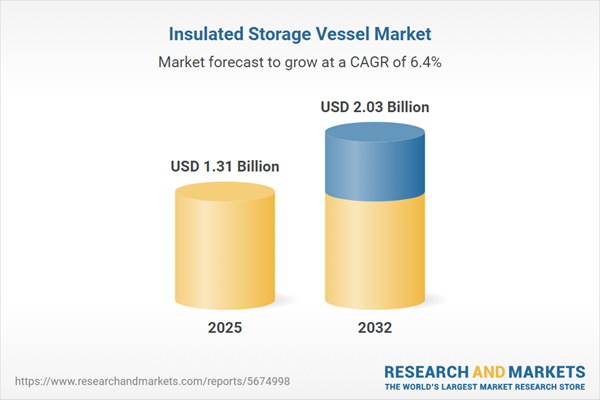Speak directly to the analyst to clarify any post sales queries you may have.
Insulated storage vessels have become essential for organizations worldwide responding to increasing regulatory pressures and complex supply chain demands. As companies move to strengthen resilience and embed sustainability throughout operations, adoption of advanced insulated storage solutions allows them to remain compliant, efficient, and adaptable.
Market Snapshot: Insulated Storage Vessel Market Size and Growth Trajectory
The insulated storage vessel market is experiencing robust growth, currently valued at USD 1.23 billion in 2024, with projections indicating an increase to USD 1.31 billion next year. Looking further ahead, analysts expect the sector to climb to USD 2.03 billion by 2032, thanks to a compound annual growth rate of 6.44%. This positive trend is attributed to growing global demand for mobility solutions, expanding sustainability programs, and more investment in thermal efficiency. The addressable market now covers diverse applications in residential settings, hospitality, and pharmaceuticals, underlining the sector’s vital role in enabling secure and adaptable supply chains for a wide range of industries.
Scope & Segmentation: Comprehensive Analysis of Insulated Storage Vessel Market
- Material Types: Includes aluminium, glass, durable plastics such as polyethylene and polypropylene, and high-grade stainless steels (304 and 316), all designed to meet strict operational and compliance standards across varied sectors.
- Insulation Technologies: Covers foam and vacuum insulation, which deliver accurate temperature control and help enterprises reach ambitious energy efficiency objectives.
- Container Sizes: Serves needs from compact containers below 500 ml, through versatile mid-sized options, to large vessels above 1500 ml, accommodating everything from portable use to industrial-scale processes.
- Application Range: Supports both hot and cold liquid management plus dual-temperature functionality, making these vessels indispensable in homes, healthcare facilities, and manufacturing environments requiring steady temperature maintenance.
- Distribution Channels: Purchased via direct online orders, well-known ecommerce platforms, and brick-and-mortar retail stores, streamlining procurement for institutional buyers and end customers alike.
- End User Categories: Addresses the needs of residential consumers, hospitality and business operators, as well as industrial companies including chemical, pharmaceutical, and processing enterprises, with tailored solutions for each segment.
- Regional Coverage: Adoption is strong throughout the Americas, Europe, Middle East & Africa, and Asia Pacific, reflecting differing regulatory requirements and customer expectations in each region.
Key Takeaways for Senior Decision-Makers
- Product innovation remains central to ongoing market relevance, as sustainability frameworks and operational requirements continue to evolve rapidly across geographies and sectors.
- Enhanced collaboration among manufacturers, material scientists, and logistics providers is helping build more resilient, responsive supply chains in environments with heightened regulatory oversight.
- Adaptable go-to-market strategies, including regional product customization, are crucial for meeting the unique compliance obligations and diverse customer needs found in global markets.
- Growing demand in both commercial and residential applications is increasing the appeal of modular designs, enabling users to swiftly adjust vessels for varying operational contexts.
- Digital procurement and direct-to-customer sales models foster faster feedback cycles, facilitating continuous improvement and closer relationships between producers and end users.
Tariff Impact: Navigating New Regulatory Headwinds
Anticipated U.S. tariffs in 2025 are prompting companies to reevaluate their procurement and supply chain approaches for insulated storage vessels. Many organizations have begun prioritizing local sourcing and expanding regional manufacturing to counteract material price volatility. Flexible supplier contracts and procurement strategies are increasingly standard, supporting responsiveness amid regulatory shifts. These locally adaptive, collaborative supply chain practices are essential in sustaining operational stability as policy environments evolve.
Methodology & Data Sources
This report is grounded in a methodical blend of industry leadership interviews, technical expert consultations, and insights from end users. The research synthesizes peer-reviewed scientific literature and up-to-date regulatory documents, combining both qualitative and quantitative approaches—such as scenario analysis and focused surveys—to provide senior stakeholders with reliable and actionable market intelligence.
Why This Report Matters
- Equips senior leaders with segmented and actionable insights for guiding strategic insulated storage vessel investments and risk management.
- Delivers timely, practical intelligence on market trends, regulatory changes, and evolving priorities across key regional and sectoral contexts.
- Offers supply chain recommendations that support both operational resilience and the ongoing shift toward sustainable storage technologies.
Conclusion
Long-term success in the insulated storage vessel market depends on continuous product development and agile supply chain adaptation. Companies well-prepared for regulatory adaptation and technological evolution will capture new opportunities and preserve strong market positions.
Additional Product Information:
- Purchase of this report includes 1 year online access with quarterly updates.
- This report can be updated on request. Please contact our Customer Experience team using the Ask a Question widget on our website.
Table of Contents
3. Executive Summary
4. Market Overview
7. Cumulative Impact of Artificial Intelligence 2025
List of Figures
Samples

LOADING...
Companies Mentioned
The key companies profiled in this Insulated Storage Vessel market report include:- Thermos L.L.C.
- Stanley Black & Decker, Inc.
- YETI Holdings, Inc.
- Newell Brands Inc.
- Zojirushi Corporation
- Helen of Troy Limited
- SIGG Switzerland AG
- CamelBak Products, LLC
- S'well Bottle LLC
- Cascade Designs, Inc.
Table Information
| Report Attribute | Details |
|---|---|
| No. of Pages | 197 |
| Published | October 2025 |
| Forecast Period | 2025 - 2032 |
| Estimated Market Value ( USD | $ 1.31 Billion |
| Forecasted Market Value ( USD | $ 2.03 Billion |
| Compound Annual Growth Rate | 6.4% |
| Regions Covered | Global |
| No. of Companies Mentioned | 11 |









